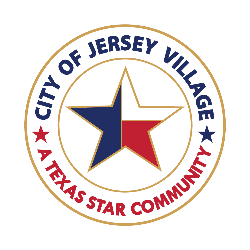As a part of the initial stages of the Journey to 2035 Comprehensive Plan, an online survey was utilized to gather public input regarding the development of Jersey Village. This opportunity to submit feedback is critical in understanding residents’ vision for Jersey Village and structuring the goals for the Journey to 2035 Comprehensive Plan.
Survey Period: October 29, 2024, through December 16, 2024
Number of Questions: 35
Number of Responses: Total responses: 375; Complete responses: 259
Collection Methods: All survey responses in this summary were collected through this Website.
Download Survey SummarySummary and Key Findings
Before taking the survey, respondents were required to provide their name, address, and zip code to ensure that the feedback analyzed portrayed the sentiment of residents within the community itself. All 259 complete survey responses were from individuals who indicated that indeed lived in Jersey Village.
Demographic Information
Survey responses were provided from a wide range of age groups, though the largest concentration of respondents is middle aged (34 – 64). Most respondents identify as female (63%).
- Under 18 (0%)
- 18 – 24 (0.4%)
- 25 – 34 (8.4%)
- 35 – 44 (28.9%)
- 45 – 54 (14.5%)
- 55 – 64 (20.5%)
- 65 – 74 (14.5%)
- 75 or older (11.2%)
- Prefer not to say (1.6%)
Household Characteristics
Most survey respondents described their household as a couple with children (47.6%). 6.5% of respondents are single, 20.3% are couples with no children, 2.9% are single parents with children, and 18.3% of respondents are retired. Of those who opted to specify the description of their household, 72.8% of respondents were couples with older children who no longer live at home or deemed to be “empty nesters.” Households represented in the survey largely consisted of 2 – 5 individuals.
Household Income
Annual household incomes of respondents predominantly range from $100,000 to over $200,000 (57.62%), with the largest group earning over $200,000. These responses reflect greater concentrations of earnings in the upper-income brackets. There are no responses from residents who identified a household income of less than $15,000. However, almost a third of all respondents chose to not disclose their earnings (30.04%) which may distort an accurate profile of the annual incomes of households in Jersey Village.
Length of Residency
The largest group of respondents have lived in Jersey Village for more than 20 years (37.5%), followed by 23.2% of respondents having lived in the city between 11 – 20 years. Well over a majority of respondents have called Jersey Village their home for at least a decade, highlighting their commitment to the city and speaking to the strength of Jersey Village’s community.
Community Perceptions
Quality of Life
Overall, responses suggest a generally positive perception of the quality of life in Jersey Village. When asked to rate the overall quality of life between 1 and 5, with 1 indicating “poor” and 5 indicating “excellent”, responses concluded a weighted average rating of 4.22. A further breakdown of responses highlights that 0.8% of respondents valued the quality of life as 1 or “poor,” 0.4% valued it at 2, 12.7% valued it at 3, 48.3% valued it at 4, and 37.5% valued it at 5 or “excellent”. An overwhelming majority of responses are concentrated within a 4 or 5 rating, suggesting that respondents find the overall quality of life in Jersey Village satisfactory.
Positive Features of Jersey Village
An open-ended survey question allowed participants to comment on what they valued or liked most about Jersey Village. The emerging themes from these responses are as follows:
- Safety and Security (dominant theme). Jersey Village residents express great satisfaction with the responsiveness and dedication of Jersey Village’s emergency services, particularly that of the police and fire departments. Respondents also appreciated the responsiveness of the city government and attentiveness towards issues throughout the city. Feeling comfortable at night, on the nature trails, and in the neighborhoods, respondents emphasized that the safety of Jersey Village makes it a desirable place to reside.
- Community-Oriented Culture. From community events to connections with neighbors, respondents praised the strong community ties that are built in Jersey Village. Great rapport and support among residents have created a friendly atmosphere that many respondents highlight.
- Small-Town Feel. Jersey Village has been able to maintain a small-town feel despite being near a major urban area. The small-town characterization is appealing to many respondents and built through the many community events, active participation from city staff, friendliness of neighbors, and sense of belonging.
- Location and Proximity. Located in the Houston–Sugar Land–Baytown metropolitan area, major transportation corridors such as US Highway 290, Beltway, and FM 529, make Jersey Village an ideal location to live, offering access to larger urban areas, such as Houston, while maintaining the city’s small-town charm.
- City Services and Amenities. Beyond safety, residents value the city services provided, including parks, the pool, and other recreational facilities.
Challenges and Issues of Jersey Village
Respondents were also free to express issues they felt should take priority in Jersey Village. The survey allowed participants to select up to three priority items and specify their own if an issue was not listed. Flooding and stormwater management, safety and crime prevention, and traffic and road conditions were the most important issues that respondents felt should be focused upon. Housing affordability, on the other hand, was the least selected issue within the city.
The “Other” responses provide valuable qualitative insights into specific concerns not captured by the main categories. Recurring themes include:
- Community Pool. A significant number of respondents mention the desire for a new or improved community swimming pool. While “Parks and Recreation” was selected by a substantial number of respondents, the pool is a particularly salient issue.
- Infrastructure and Development. Several responses mention infrastructure needs beyond water/wastewater, including transportation corridors and better roadway connectivity—especially across the golf course—and the expansion of grocery, entertainment, and dining options. There are also comments about the aesthetics of the neighborhoods and desire for more dining and entertainment options, which relate to development.
- Fiscal Responsibility and Taxes. Concerns about taxes and the city’s fiscal responsibility are present in several responses.
- Schools. The quality of local schools is mentioned by a few respondents, although education is not a direct responsibility of the city.
Housing
Survey respondents were asked to evaluate current housing options in Jersey Village and assess what development of future housing stock could look like. Responses suggested that many feel that Jersey Village’s current housing options adequately fulfill the needs of the city.
Housing Options
When asked to rate the housing options in Jersey Village on a scale of 1 to 5, with 1 equating to “not enough options” and 5 equating to “plenty of options,” a weighted average score of 3.99 suggests that respondents generally believe that there is enough housing inventory in Jersey Village, though some expansions may be desired. When looking further into the responses, most participants selected a rating of 3 or higher (94.6%), while 5.4% of respondents felt that the current housing options are not enough to serve Jersey Village.
Many indicated that future housing developments were seen as unnecessary as current housing options meet the city’s needs. Those who did select a housing option, given a variety of selections, felt that single-family housing stock should be increased in the city, followed by senior/retirement housing, townhomes, affordable housing, and multi-family housing or apartments. Those who provided additional comments provided a mix of opinions with some expressing concern over multifamily housing jeopardize the unique character is the city, others in favor of accessory dwelling units and walkable amenities, and those who feel that housing should not be a primary concern of the city.
Transportation
From a scale of 1 to 6, respondents were asked to rank various modes of transportation based on the importance of the transportation type to the participant. The most important mode of transportation for Jersey Village residents, who took the survey, is driving, followed by walking or biking, and golf cart. These results suggest Jersey Village is heavily reliant on personal vehicles, but that walking and biking are highly valued, suggesting that residents appreciate opportunities for active transportation. The transportation modes are ranked as follows based on the average score for each option:
- Driving (5.64)
- Walking or Biking (4.73)
- Golf Cart (3.34)
- 4) Rideshare (2.75)
- Public Transit (2.53)
- Other (2.01)
Quality of Transportation Infrastructure
The conditions of roads, streets, and sidewalks were inquired to gain an understanding of how residents perceive existing quality transportation infrastructure. Respondents offered a weighted average rating of 3.57 out of 5, where 5 is equivalent of “excellent” quality and 1 is equivalent to “poor” quality, suggesting that while infrastructure quality is generally positive, improvements can and should be made.
Transportation Improvements
Respondents were allowed to select up to two transportation improvements. The most popular improvements are that of more sidewalks and bike paths for pedestrians and cyclists (106 responses) and better traffic flow and signal timings (106 responses). This is followed by better road maintenance (65 responses).
Common themes were noted among respondents who chose to specify their desired improvements. The most popular responses suggested improvements to Rio Grande Street, namely an extension or connection between the Jersey Meadow Golf Course to Rio Grande Street, via a bridge. Sidewalk improvements were also listed, focusing on increasing the number of sidewalks—especially in high pedestrian traffic areas—and enhancing the quality of existing sidewalks, desiring smoothness and leveling of existing and new sidewalks.
Traffic congestion related to school drop-off and pick-up times is a significant concern among respondents, with mentions of speeding and the potential need for dedicated school access roads. As it relates to traffic congestion, respondents mention concerns about traffic flow beyond signal timing—particularly at intersections like DeLozier & Rio Grande and Village Green onto Jones. Suggested solutions include turn lanes and additional access points to major roads (Beltway 8, 290, and Jones Road).
Natural Disasters and Emergency Response
Natural Disasters
Given the geographic location of Jersey Village, the most common natural disaster hazards to Jersey Village tend to be that of flooding (75.3%) and hurricanes or coastal storms (61.78%), which is reflected in survey respondents’ opinions of disaster threats to the city. Wind/tornado (30.9%), drought (29.3%), extreme heat (22.4%), winter storms (20.9%), and hail/lightning (13.5%) follow respectively. Wildfire and earthquake concerns acquired zero responses, indicating that these hazards do not concern residents. On average, respondents are moderately concerned about natural disasters impacting Jersey Village (3.54 weighted score between 1 and 5, with 1 being “not concerned at all” and 5 being “extremely concerned”).
Disaster Damages
Within the past five years, 58.3% of respondents revealed that their home or business has been affected by a natural disaster, with 41.7% respondents not being affected. The monetary value of damages ranges between $600 to $100,000. Primarily, respondents reported damages from hail, extreme winds, freezing temperatures, and flooding, resulting in roof damage, uprooted and fallen trees, pipe bursts, power outages, leaks, fence replacements, and general foundation or property damage.
Emergency Preparedness
Many respondents share an overwhelmingly positive feedback of Jersey Village’s communication and education for disaster preparedness.
Emergency Preparedness Improvements
Respondents feel that expanding the avenues of communication, when disseminating information about disasters and emergencies, would greatly improve the way that Jersey Village prepares for emergencies. Many suggested city-wide text emergency alerts, emails, or phone calls are methods of communication to consider beyond updates to the city website or social media, in the event of flooding, tornadoes, or derechos. Increasing the volume of warning sirens and greater distribution of sirens across the city is another recommendation made by respondents. More minor recommendations include improving electrical infrastructure and better flood mitigation techniques.
Parks and Recreation
Parks and Recreation Facilities Visitor Frequency
Visitation rates of parks and recreational facilities in Jersey Village vary, ranging from frequently used to never. A significant portion of respondents frequently (28.2%) and somewhat often (36.7%) utilize the city’s facilities. 30.5% of survey responses note that these facilities are not used very often and 4.6% of respondents never use the city’s recreational facilities. Given these results, a weighted average score of 3.97 out of 5, with 1 being “poor” and 5 being “excellent”, regard favorable opinions about the availability of the city’s parks and recreational opportunities, though the score leaves room to improve the availability of these facilities.
Barries to Parks and Recreation Usage
The following barriers were presented as options that may prevent survey respondents from parks and recreational facility usage:
- None
- Limited Amenities – Weather (tied)
- Other
- Lack of Interest
- Trail Sustainability
- Distance – Maintenance (tied)
- Crowding
- Accessibility
In analyzing the “Other” responses, valuable insights can be gleaned, including:
- Pool Issues. The lack of a good community pool is a major recurring complaint. Some mention the age of the existing pool and the limited time it’s open.
- Safety Concerns. Several respondents mention safety concerns, including loose dogs, suspicious people on trails, and lack of lighting.
- Accessibility and Connectivity. Issues with sidewalks (especially along Jersey Meadows Dr.), the closure of the golf course bridge, and parking are mentioned as barriers to access.
- Maintenance and Cleanliness. Concerns about the condition of park equipment (Carol Fox Park), dirty bathrooms, and muddy grounds are raised.
- Time Constraints. Several residents cite time constraints due to work schedules or other commitments.
- Teen-Specific Amenities. A lack of amenities geared towards teenagers, such as a skate park, is mentioned.
- Crowding. While “Crowding” was an option in the multiple-choice section, some “Other” responses elaborate on this, mentioning that they avoid the parks when they are busy.
- User Demographics. Some residents mention that they no longer have children at home or that their age limits their ability to use the parks.
Desired Amenities
Of the offered options, tennis/pickleball courts and bike paths are the most popular facilities that respondents would like to see added in Jersey Village. Many also seem to be in favor of not adding anything additional to parks and recreational facilities. EV chargers are the least popular facility or amenity option.
An additional open-ended answer option was provided to respondents who chose to specify what amenities they would like to see in Jersey Village. By far the most popular answer was a new, improved, or reopened community pool. This echoes concerns and suggestions made in previous questions. Respondents were also interested in a community gym, walking paths and wider trails, better shading mechanisms, and improved sports fields.
Commercial and Business
When asked about potential commercial and business opportunities for Jersey Village, respondents provided an array of answers. Conclusively, restaurants and cafes are the most desired in the city (83.0%). Small, local businesses follow (57.9%), trailed by retail stores and shops (47.9%), entertainment and recreational venues (42.5%), professional services (23.9%), and fast food (15.4%). Respondents seem less interested in the development of industrial or manufacturing businesses, garnering just 3.9% of all selections. Those who opted to specify boldly indicated that a larger and newer grocery store should be a priority item of the city, such as HEB, Trader Joe’s, or Sprouts.
Business Attraction
Respondents offered a range of responses when asked in an open-ended question what the city should focus on to attract new businesses. The themes of these responses are as follows:
- Tax Incentives and Advantages
Many survey respondents listed tax incentives as a primary strategy that the city should focus on to attract new businesses. Tax incentives would work to bring in more businesses, be it retail, dining or shopping, allowing benefits for residents as well. Respondents also suggest that the lower property tax in Jersey Village, when compared to other cities in the metropolitan area, would work as a significant advantage in garnering business.
- Small-Town Charm
Respondents also highlight that Jersey Village’s unique charm and character would be particularly appealing to businesses, and thus the city should work to play up the city’s identity and character. The focus should remain on preserving and sticking to the values of Jersey Village.
- Safety, Location, and Proximity
The strengths of Jersey Village’s safety, location, and proximity, namely three characteristics that respondents have previously deemed appealing about the city, are listed as focus areas that businesses may find desirable.
- Quality of Life Developments
Respondents also took the time to specify the types of businesses they would like to see in the area. Many expressed a distaste for more smoke shops in the city. Rather, “quality of life” developments, such as entertainment, dining, and shopping, are among the more popular options for residents.
2020 Comprehensive Plan
When asked about survey participants’ familiarity with the 2020 Comprehensive Plan, nearly half of all respondents expressed that they are not familiar with the plan at all.
Plan Familiarity
- Not familiar at all (49.5%)
- Somewhat familiar (44.4%)
- Very familiar (6.2%)
Regardless of this unfamiliarity, many indicated a belief that the city of Jersey Village has made moderate progress towards goals set in the last Comprehensive Plan, with results displaying a weighted average of 3.24 (between 1 and 5).
According to survey respondents, areas from the 2020 Comprehensive Plan that need further progress or attention include:
- Community Pool. Respondents show strong support for the development and upgrade of a community pool, emphasizing the desires for a new community space.
- Parks and Recreation Facilities and Spaces. Parks and recreational facilities are mentioned many times in respondents’ responses, expressing the need to update and expand such spaces. Some responses also show an appreciation of the use of smaller parks for community events and hope to see this continue in the future.
- Community Aesthetics. Complaints about signage and building vacancies and deterioration highlight a desire from the community to prioritize upkeep and general aesthetics of Jersey Village neighborhoods.
- Infrastructure Upgrades. Improvements to wastewater management systems, sidewalk conditions, road connectivity, and lighting were talking points among respondents. Survey participants wish to see better care and work to infrastructure in Jersey Village.
- Flood Mitigation. Continuing flood mitigation efforts is mentioned, with one resident raising concerns about the accuracy of FEMA maps.
Only 30.9% of survey participants opted to provide feedback for the above questions, which indicates that the mentioned areas of attention represent the opinions of less than half of all respondents.
Looking Forward
When asked about the future of Jersey Village and what respondents hoped to see, a variety of answers—representing the unique needs of residents—drew some similar themes.
- Pool, Parks, and Recreation. Respondents are passionate and supportive of a new or updated community pool. This was by far the most popular answer among participants. They were also interested in more amenities and activity spaces for families, park and green spaces, and a community recreation center.
- Commercial and Retail. Increased access to shops and improved retail spaces is also a common response from respondents, emphasizing a need for dining, entertainment, and shopping options that residents want to see in Jersey Village. A few respondents go on to say that these businesses should appeal to young families and younger individuals of the community.
- Infrastructure. As mentioned previously, many survey respondents wish to see continued improvements to Jersey Village’s infrastructure. Especially when it comes to road and sidewalk maintenance and water or sewer management, respondents show a strong desire to improve current infrastructure conditions before starting anything new.
- Greater Road Connectivity. Many respondents hope to see better connectivity throughout Jersey Village. The disconnect experienced between Jones Road and the rest of the Jersey Village community, due to the golf course, has participants asking for a bridge connection between the two sides of the city or simply some other form of roadway connectivity.
Overall, respondents hope to see a future that balances growth and improvement with the preservation of the city’s unique character. This is a common theme across many communities. Respondents prioritize a new pool, better connectivity, improved infrastructure, and attracting desirable businesses. They also want to see a continued focus on safety, beautification, and community engagement.
Next Steps
This data will serve as a guide throughout the planning process with additional opportunities provided for residents and stakeholders to further refine our understanding and ensure community input is fully integrated.



